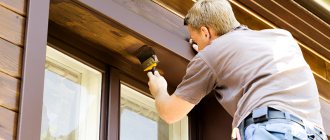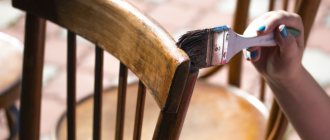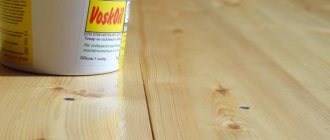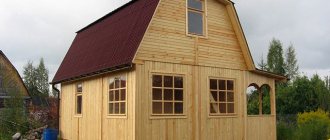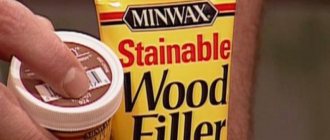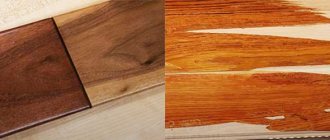Wonderful building material - Tree to this day remains the most popular material used in the construction of houses, structures, floors, roof structures, etc., although the modern market offers a variety of modern building materials. When constructing cottages, private houses, and buildings, preference is given to wood. The reason is that wood is a technologically advanced, lightweight, quite durable, natural material. Wood structures have many advantages. Wooden houses and natural wood floors are valued for their environmental friendliness, ability to retain heat, and normalize indoor humidity. But along with the many advantages of wood, unfortunately, there are also serious negative properties of the material. These properties include: good flammability, rotting, tendency to mold, tendency to infest bugs and parasitic fungi. In a word, biofactors and weather conditions irreversibly cause the destruction of wood.
However, humanity has found a way out of this situation and came up with ways to protect wood from the influence of harmful factors. After applying a set of measures to protect wood, the service life of this material increases many times, and its performance properties remain at the proper level. Let's take a closer look at wood protection measures.
Before carrying out any carpentry work, the wood must be treated with antiseptic compounds. This measure helps protect wooden structures from rot, mold, fungal development, as well as from damage by various insects. After which the wood must be treated with fire retardants, which helps make the material less flammable and more resistant to fires. We will look at the types, purposes and methods of using antiseptics in this article.
Classification of wood antiseptics according to the composition of the substance
Depending on what components a particular product is made from, antiseptics are divided into several types:
- Water-soluble substances (antiseptics) are often used for preventive purposes. Such compositions are used to treat those surfaces that will not have direct contact with moisture or water. When choosing such an antiseptic, you should take into account that after processing the material it will need to dry for some time. In some cases, after applying a water-soluble antiseptic, the wood may crack and become deformed. They have low toxicity, are odorless and are excellent for treating indoor floors. Both antiseptics and fire retardants can be water-soluble. Their cost is not high. They can be produced in the form of a ready-made solution or powder that requires dilution with water.
- Oil compositions are used where it is necessary to protect wood from moisture and the environment. The disadvantage of this impregnation is its flammability, as well as an unpleasant odor that can persist for a long time. Oil antiseptics change the color of the material. Oil impregnations are applied independently, without finishing with varnishes and paints.
- Organic antiseptics based on organic solvents are used to treat wooden structures and parts both outside and inside buildings. A thin film of antiseptic covering the surface of the wood performs adhesive and hydrophobic functions. However, their price is much higher.
- Combined antiseptics combine several different properties. Along with the ability to protect the material from fungi, mold and parasites, they also play the role of fire retardants. Antiseptics that protect wood from fire are called fire retardants.
When choosing an antiseptic, you should pay attention to the recommendations for use, as they can be suitable for both outdoor and indoor use.
Types of fire-resistant products
Wood is protected from fire using impregnations or coatings.
The latter type includes paints, varnishes and special pastes. It is used much less frequently, as it has a significant drawback. Coatings completely hide the natural structure of the wood, which negatively affects the appearance of the entire structure. For this reason, they are recommended to be used only on hidden surfaces. Fire-resistant impregnations do not paint over beautiful wood reliefs and even emphasize them.
This type is divided into weather-resistant and unstable solutions. Non-permanent (in other words, washable) products are used in enclosed spaces where the humidity level does not exceed 70%. Such solutions are characterized by low cost. To treat facades, wood impregnation for exterior use is used, which is endowed with increased resistance to moisture.
Antiseptics for wood processing are divided into 2 types, depending on the impregnation method.
Modern manufacturers offer a huge selection of wood antiseptics, depending on the destination and conditions of use. Thus, there are antiseptics for baths and saunas, terraces and gazebos, protection of wood during the construction stage, etc. They have various properties of moisture resistance, fire resistance, and rot resistance.
Protective paints and varnishes
As mentioned earlier, wood can be protected using wear-resistant facade varnishes and paints. Such coatings are divided into 2 categories: intumescent and non-intumescent.
The first group is distinguished by the fact that when the temperature rises, the material begins to crack, moisture and inert gas are released, as a result of which the fire does not spread to the wood.
The products of the second group contain fire-fighting fillers and liquid glass. Such coatings can resist fire for 100 minutes.
With the help of paint and varnish compositions, protection against mold, rot and colonization by microorganisms is provided.
Classification of solutions by area of application
Depending on the type of wood and the purpose of the material, you should select the appropriate composition.
Depending on the area of application, there are 2 types of antiseptics:
In turn, substances for external use are divided into 2 types:
impregnations are compounds that can penetrate quite deeply into the structure of wood and destroy mold, fungi and harmful insects;
finishing coatings exist in order to protect the impregnating layer from weathering. Such a composition cannot penetrate deeply into the wood structure, but is capable of forming an impenetrable film on the surface of the material.
Impregnations and finishing compositions can be used separately, but you can also choose a combined preparation that performs several functions at once.
It is worth noting that any antiseptic for wood has some toxicity, so when using the substance it is important to adhere to safety precautions and observe the specified proportions.
Before choosing a particular antiseptic, do not forget to carefully study the information about the substance and read the instructions for its use. The fact is that certain substances can cause metal corrosion, interact with sealants and adhesives, and simply be too toxic and poison the environment.
Positive features of the fire retardant procedure
1. High degree of protection of buildings from fire. In the event of a fire, wooden structures may char but will not catch fire.
2. Fire-resistant impregnations have many types, differing in composition, purpose and cost. Therefore, the buyer can choose an option that meets any requirements.
3. The process of applying the product to wood is quite simple; the treatment can be carried out with your own hands, without resorting to the expensive services of specialists.
Antiseptics – protection against mold, microorganisms, rotting
These antiseptics prevent the destructive effects of insects, fungi, viruses, foulbrood and other pests on wood. Antiseptics for external use contain substances that protect the surface from ultraviolet radiation and precipitation. Many antiseptics have water-repellent properties. This eliminates the possibility of cracking and torsion of wooden structural elements during prolonged exposure to moisture.
Antiseptics can be prophylactic or therapeutic.
Prophylactic formulations are the most common. They are used to treat undamaged wood before carpentry or construction work - for its subsequent protection during operation. One of the representatives of such antiseptics is Neomid 400, Neomid 430, which forms a colorless film on a wooden surface that does not allow insects and bacteria into the tissue.
Therapeutic antiseptics contain more aggressive components that not only repel, but also destroy tree pests. Healing solutions are used on wood that has already been partially damaged. The medicinal composition Neomid 100 Anti-bug has proven itself to be excellent, having a detrimental effect on bark beetles, shawls and other insect pests. The antiseptic Wood Healer DL-2 has a similar effect.
Product consumption and service life
Salt solutions adhere very poorly to wooden surfaces, so to achieve the maximum degree of protection, it is necessary to use at least 400 grams of the product for each square meter of surface.
Due to weak fixation, the impregnation does not penetrate deep into the wood and is quickly washed out. For this reason, re-treatment should be carried out no later than after 2 years.
Non-salt impregnations penetrate the wood structure very easily, so impregnation will require much less solution. Approximately 280 grams of product should be used per 1 m2. The service life of such protection is 5 years for outdoor use and 15 years for indoor use.
The frequency of coating with paints and varnishes is 6-7 years.
During the operation of wooden surfaces, it is necessary to regularly inspect their condition. If chips appear, protective coatings are noticeably falling off, or the impregnation has been washed off by more than 70%, re-treatment should be carried out as soon as possible.
Fire retardants – fire protection
Fire-retardant impregnations protect wood from thermal destruction under the influence of fire or high temperature. The chemicals that make up fire retardants create compounds at high temperatures that prevent ignition or flame spread. Naturally, fire retardants are not a complete fire protection guarantee. They allow wooden surfaces to resist fire for a short time (about 10-15 minutes when heated to 700? C). Fire retardants are recommended to be used to protect wooden floors in rooms, attics and others. Fire retardants are represented by such brands as Neomid 530, Pirilax Fire Protection, Fire Bioshield and others.
Fire retardants - impregnations to impart fire-resistant properties
Based on their mode of action, fire-prevention impregnations are divided into 2 groups.
Fire retardants, which prevent combustion, begin to release non-flammable gases when the temperature rises. They push access to oxygen away from the surface of the wood and thereby make combustion impossible. Blocking flame retardants form a special film on the surface of the wood. When exposed to fire, this film swells and blocks the access of oxygen (necessary for combustion) to the protected surface. Paints, primers, varnishes, plasters, etc. can be applied over fire retardants. Fire-fighting impregnations are often used in combination with antiseptics. For best results, it is recommended to first apply a layer of antiseptic to the surface, then a layer of fire retardant. For example, you can use the following scheme: the first 2-3 layers are Neomid 400 antiseptic, the next 2-3 layers are Neomid 530 fire protection.
Useful tips for treating with fire retardants
Whatever fire retardant is chosen for impregnating wood, the reliability of protection depends on strict adherence to the rules for its application. Thus, treatment with saline solutions should be carried out exclusively in warm weather, at an air temperature of 5 to 25 degrees and low humidity. Contact with metal elements should be avoided, as high salt content can cause corrosion.
Water-based fire retardants for wood should not be used to impregnate old and dry wood, as it will absorb moisture and swell.
Non-salt impregnations can be used in the temperature range from – 15 to + 40 degrees. These types penetrate the structure of the material as quickly as possible, but are toxic. Based on this, these products can only be used for outdoor work.
The surface to be treated must be sufficiently dry and not covered with paints, varnishes or other compounds. Preheating the wood allows you to increase the depth of penetration of the protective agent from 3-4 mm to 5-8 mm.
Combined impregnations - two in one
If it is necessary to protect the wood surface from fire and biological pests at the same time, you can use combined impregnations. They contain both fire retardants and antiseptics. Among such products: Senezh Ognebio, Neomid 450, Bioneutral W 31, BS-13.
Fire protection - antiseptics and fire retardants in one solution.
Whitening antiseptics
To provide protection and at the same time restore the original color of aged or damaged wood, to “rejuvenate” it, special bleaching antiseptics are used. The most popular of them include the following.
The compositions of the “Bioshield” will “treat” surface biological damage to wood, create protection for the future, and restore the natural color of the material.
“Bioshield 1” and “Bioshield 2” - these impregnations are designed to prevent surface putrefactive processes occurring in wood under the destructive influence of pathogenic microflora. In addition, they are able to preserve the physical and technical characteristics of the processed material, as well as restore the healthy natural color of unpainted wood.
If wood damage is at the initial stage, then you can use Bioshield 1. After the treated surfaces have dried, they can be painted or finished with other decorative materials.
In case of severe damage to the tree by mold or lichen, it is necessary to use the Bioshield 2 product.
Both of these compositions are well suited for processing wood used in the construction of log bathhouses and houses.
“Prosept 50” will help cope with even large-scale areas of biological damage to wood.
“Prosept 50” is a domestically produced bleaching antiseptic “medicinal” product for wood. The composition perfectly removes foci of biological damage, including gray plaque, restoring the healthy color of the tree in literally 25-30 minutes, preserving its structural structure.
The penetration depth of this composition is 3 mm. And already 12 hours after applying the antiseptic to the wood, it can be painted or covered with insulating material or wallpaper.
"Prosept 50" is an environmentally friendly solution, so it can be used for both external and internal treatment of wooden surfaces. In addition, it is even used to process wooden pallets on which food products are transported and stored.
In order for the solution to remain in the structure of the material for as long as possible, it is recommended to additionally coat the surfaces with the preservative antiseptic agent “Neomid 430 eco” or “Neomid 440 eco”. These funds will eliminate the possibility of recurrence of foci of biological damage.
“Neomid 500” is a reliable composition that guarantees successful “treatment and rejuvenation” of wooden building parts.
"Neomid 500" - this whitening antiseptic is similar in its characteristics to the previous product. However, its cost is significantly higher, so it is not so popular among builders.
The solution is an environmentally friendly product and can be used for internal impregnation of wooden surfaces. The product is most often used by professional builders for processing wooden log buildings of bathhouses and residential buildings. Its drying time after application is 24 hours.
Sagus whitening impregnations are available in several versions. The choice of a specific one depends on the degree of identified biological damage to wood.
Whitening antiseptics are water-based. They are designed for radical removal of any type of damage caused by black mold and wood-staining fungus from unpainted wood. Solutions are also used to impregnate logs and timber for the construction of bathhouses and houses.
"Sagus" produces three types of whitening compositions - "Standard", "Profi" and "Light":
“Standard” is a solution of deep and rapid penetration into the structural structure of wood fibers. It is used at the first manifestations of mold, the appearance of lichen or moss, as well as darkening of the material as a result of exposure to ultraviolet radiation.
“Profi” is a composition that can cope with more serious damage to wood. In addition, it is suitable for impregnating surfaces built from mineral building materials (brick, gas silicate blocks, etc.).
“Light” is a product designed to lighten wooden surfaces that have darkened as a result of exposure to ultraviolet radiation, as well as when mold appears on them. The solution is distinguished by its gentle effect on the structure of wood while maintaining its original qualities.
Table. Comparative table of some antiseptics.
| Antiseptic composition | Description | Color | Consumption | Protection period |
| Antiseptic paste PAF-LST | Protection from rotting and woodworms of load-bearing and enclosing non-glued wooden structures (joists, floor boards, frames of window and door blocks, frames, embedded parts, etc.). | Gray-green | Paste concentrate – 300 g/m2; paste solution 500 g/m2 | Increases the service life of wood up to 30 years |
| Homeenpoisto | Designed for removing mold from unpainted and previously painted wooden, plastered and concrete surfaces before primary and repair painting, as well as repair painting of roofs made of fiber cement slabs and concrete tiles. | No | Depending on the degree of surface contamination | |
| Senezh Bio | The product protects wood from biological damage, deep penetration, non-washable | Colorless | 1-1.5 kg/m3 | |
| Senezh Eurotrans | Manufacturers use it to preserve the color and quality of finished lumber. Treating finished products with an antiseptic can easily take place within 8-9 months. | Colorless | 0.3-1.2 kg/m3 | |
| Neomid 440 | Designed to protect wood of various species from rotting, damage by wood-destroying and wood-staining molds, wood-boring insects, algae, mosses, and lichens. | Colorless | 250-350 g/m2 – for wood processing | up to 25 |
| PINOTEX Natural | Prevents fungal infections and wood rot; Forms a weather-resistant coating; Has dirt- and water-repellent properties; Contains a UV filter and UV stabilizer. | Natural, semi-matte | 1 liter per 8-12 m2 | |
| Valtti Aquacolor | Designed to protect wood from atmospheric loads, slows down the effects of moisture and UV radiation. | 40 colors | Sawn surface 4–8 m²/l; planed and log surface 8–12 m²/l.; | |
| BS-13 | Impregnation ensuring the production of fire-resistant wood and protecting against rot, mold, and blue stains. | Colorless | 250 – 300 ml per m/sq. | Fire protection 3-7 years; bioprotection up to 10 years |
Decorative properties of impregnations
Impregnations are produced transparent or tinted (in accordance with the manufacturer's range of tones). Only antiseptics have a decorative effect. Completely transparent (colorless) antiseptics perform an exclusively protective function without changing the natural color of the wood. The maximum they can do in decorative terms is to emphasize the structure of the wooden covering. A similar composition is Tikkurila Pinja W-Oil antiseptic. It is absolutely colorless, but can be easily tinted in any of the tones from the Tikkurila line. Tinted antiseptics are originally painted. They are either produced in a specific color range, or are tinted upon sale, according to the color chart offered by the manufacturer. Such impregnations simultaneously play both a protective and decorative role. That is, they can replace other coloring materials: primers, stains, paints, varnishes. A well-known similar antiseptic is Pinotex Classic, its color card includes 10 main tones and 20 additional ones. In addition, the Pinotex Classic composition allows you to obtain many other tones by mixing existing shades in different proportions.
What about fire retardants? Most of them are colorless and once dry are not noticeable. Others are painted pink or red, which plays a controlling rather than a decorative role. By applying colored impregnation to a wooden surface, it is easier to monitor the quality of the coloring and the absence of gaps. Decorative properties of antiseptics In addition to everything indicated, when choosing impregnation, pay attention to: Safety. Read the ingredients on the product label. Make sure that no highly toxic compounds are used in the manufacture of the antiseptic (fire retardant): arsenic, pentachlorophenol, fluorine compounds, heavy metal salts. Duration of fire and bioprotection. Fire retardants act on the treated surface for up to 7-15 years, antiseptics – for up to 10-20 years. Manufacturer. Well-known impregnating compositions that have a quality certificate and are appreciated by consumers are produced under the following brands: Pinotex (Finland), Tikkurila (Finland), Neomid (Russia), Senezh (Russia), Belinka (Slovenia).
How to check the quality of a fire retardant
In order to be sure of the fire safety of the structure being treated, you can test the quality of the purchased product.
To do this, a small piece of wood is soaked in the existing solution and allowed to dry thoroughly. The sample is then set on fire and the chemical reaction that occurs is observed. If a high-quality solution was used for processing, the piece will not burn or smolder. After 0.5 minutes, the surface of the bar may char, darken, but under no circumstances will it catch fire!
If a flame does not appear, the impregnation has been produced as required and can be used for further treatment of the building.
In conclusion, we note that timely treatment of materials and walls made of wood helps to reduce the possibility of a fire several times and even save lives. Therefore, you should not skimp on your own safety and the health of all family members. Use products from well-known and well-established brands that guarantee the excellent quality of their products.


